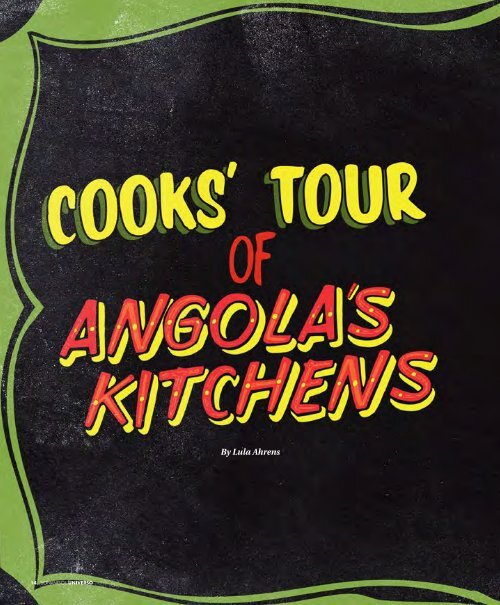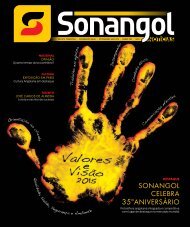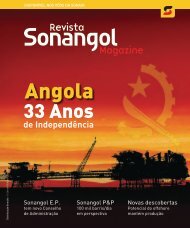PDF Format - Sonangol Limited - Oil Trading Services
PDF Format - Sonangol Limited - Oil Trading Services
PDF Format - Sonangol Limited - Oil Trading Services
You also want an ePaper? Increase the reach of your titles
YUMPU automatically turns print PDFs into web optimized ePapers that Google loves.
14 SONANGOL UNIVERSO<br />
By Lula Ahrens<br />
With Luanda’s numerous international restaurants, Angola’s own varied and<br />
colourful cuisine is sometimes unjustly overlooked. In such a large and<br />
culturally-rich country, the discovery of its food habits will always be an<br />
adventure. Universo provides a taster<br />
The visitor’s first introduction to Angolan food is<br />
usually funge or pirão, bland but filling dishes<br />
that serve as the base of most meals and are often<br />
combined with fish, chicken or meat and sauce.<br />
Funge de bombo, more common in northern Angola, is<br />
a gelatinous, colourless paste made from corn or cassava<br />
flour (fubá). The yellowish pirão, similar to polenta, is<br />
made from cornflour and is more commonly eaten in the<br />
south. During weekends, Angolan families typically sit<br />
down to funge during the day and switch to grilled meat<br />
and fish at night. But, as with everything else in Angola,<br />
there is a lot more to discover.<br />
Adventurous, experimental connoisseurs might want<br />
to try Angolan specialities such as jinguinga – goat tripe<br />
and blood –from Malange province; the Kwanza Norte<br />
delicacy kifula – game meat served with boiled and toasted<br />
palm-tree grasshoppers – or mafuma, frog meat from<br />
Cunene. Those who prefer a safer start will love caldeirada<br />
de cabrito, goat-meat stew with rice, traditionally served<br />
on Angolan Independence Day (November 11), or kizaka,<br />
the finely mashed, spinach-like leaves of the manioc plant<br />
seasoned and mixed with ground peanuts.<br />
Try mukua, the traditional Angolan dried fruit from the<br />
country’s emblematic baobab tree, it is often used to make<br />
ice cream. Cocada amarela (yellow coconut pudding),<br />
made with sugar, grated coconut, egg yolks and ground<br />
cinnamon, is less exotic but also delicious.<br />
Historic overview<br />
Five centuries of Portuguese colonisation heavily<br />
influenced Angolan cuisine. In most restaurants,<br />
Portuguese dishes such as seafood rice or bacalhau com<br />
natas (cod with cream) will be popular and available.<br />
Brazilian and other European influences have also had<br />
their impact.<br />
The roots of Angola’s major ethnic groups can be traced<br />
in local cuisine. The coastal areas of Luanda, Benguela and<br />
Namibe are known for their variety of seafood. Fish stews<br />
including caldeirada de peixe and muzongue are made<br />
from whatever is available, and served with rice.<br />
Angolan fish stews such as calulu and mufete de<br />
cacusso are believed to be excellent hangover cures that<br />
work wonders even before the very first headache sets in!<br />
A standard, superb condiment at an Angolan lunch<br />
or dinner table is gindungu, a spicy sauce made of<br />
chilli pepper, garlic, onion and sometimes brandy. Not<br />
surprisingly, some believe that the sauce is an aphrodisiac.<br />
In central Angolan villages, you will find steamed or<br />
boiled green vegetables, peas, beans, cereals and game<br />
meat. Traditional game meats consumed in parts of Angola<br />
include veal, deer, wildebeest and warthog.<br />
Typical Angolan ingredients generally include flour,<br />
beans, rice, fish, chicken, egg, sweet potatoes, manioc<br />
(cassava), yams, tomatoes, onions, peanuts, okra and<br />
various spices such as chilli. Kizaka manioc plant leaves are<br />
CULTURE<br />
DECEMBER 2012 15








